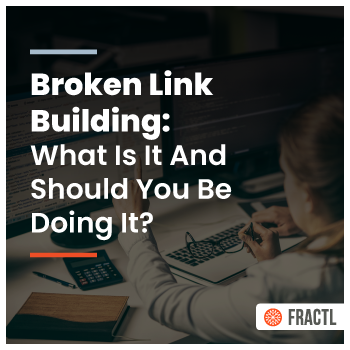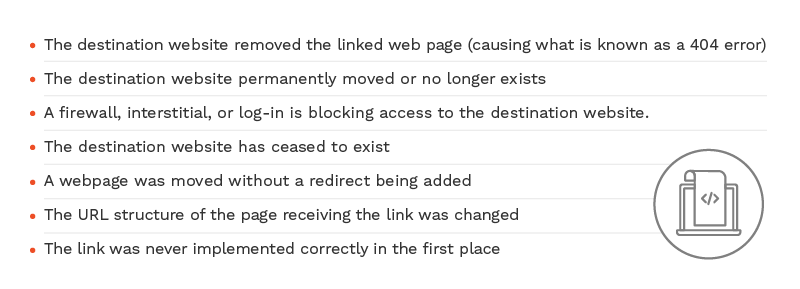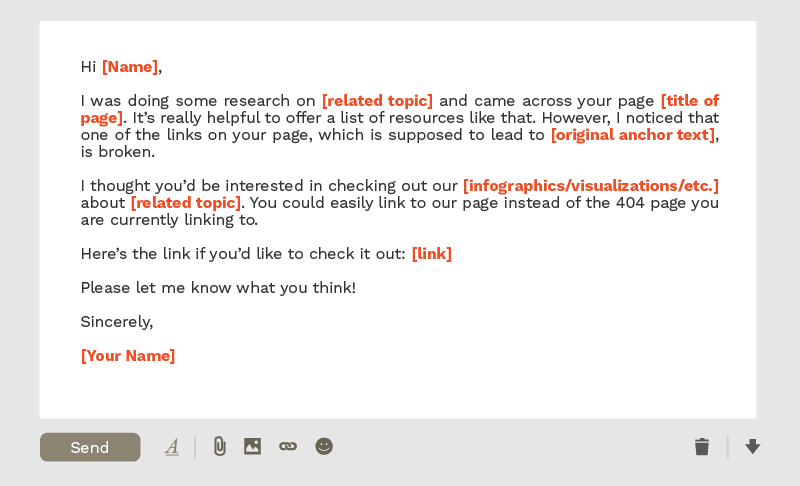Broken link building is an oft-cited link building practice, for good reason.
It’s a link building practice with a primary focus on quality content and, arguably, a drive to improve the internet. While these characteristics are appealing and have the potential to improve your standing in the SERPs, broken link building can be a tedious tactic that depends heavily on uncontrollable variables.
This article will give you a comprehensive view of what broken link building is, how to implement it, and how it compares to content marketing.
What is Broken Link Building?
Broken link building is a technique built on the practice of finding “broken links” on websites and reaching out to webmasters to receive a backlink from the identified broken link. In this context, a broken link refers to any instance in which a website intends to link to another website but the link is non-existent.
This tactic is primarily used by SEO professionals for the purpose of building more backlinks with relatively low-effort; additionally, it’s considered a “white hat” practice, which allows for easier buy-in from clients and does not run the risk of penalties from Google.
Broken links occur for a variety of reasons, including:
- The destination website removed the linked web page (causing what is known as a 404 error)
- The destination website permanently moved or no longer exists
- A firewall, interstitial, or log-in is blocking access to the destination website.
- The destination website has ceased to exist
- A webpage was moved without a redirect being added
- The URL structure of the page receiving the link was changed
- The link was never implemented correctly in the first place
As you can tell, broken links naturally occur across the internet in various ways. The question becomes not only how to fix them, but how to find them.
How can you find your own broken links to fix?
If you want to fix a broken link, first you have to find it. Let’s consider two step-by-step methods for prospecting for and finding broken links. While the fundamentals of these two approaches align closely, the first method begins with identifying sites you would like to receive a link from, while the second method begins with sites you are competing against in the SERPs.
Claiming broken links from non-competitors within your vertical
- Compile a list of websites within your vertical that you wish you had a link from. Begin with a list of 30-50 websites—all non-competitors—that appear to have high PageRank, Domain Authority, or whatever metric you wish to use.
- Run these websites through a “dead link checker” to discover if they are linking out to any 404s. Some tools you can use include Broken Link Check, Dead Link Checker, or other tools of this style.
- Create a list of web pages containing broken links, alongside the webmaster, their contact info, and the content you already own that would appropriately replace the broken link.
- Conduct outreach, emailing webmasters to request that your link be inserted to replace the broken links.
- Follow up as appropriate to ensure you earned the link effectively.
Claiming broken links that previously linked to competitors
- Compile a list of the top 5 websites you want to beat in the SERPs.
- Use backlink-auditing tools to analyze broken links points out each of these websites. Examples include tools like Moz’s Open Site Explorer, AHrefs, and SEMrush. You can easily extract all the backlinks to pages relevant to your content, via these tools. (Note that, from here, the process is nearly identical to that above).
- Create a list of web pages containing broken links, alongside the webmaster, their contact info, and the content you already own that would appropriately replace the broken link. One difference between this and the method above is that we recommend tracking which competitor previously owned the link.
- Conduct outreach, emailing webmasters to request that your link be inserted to replace the broken links.
- Follow up as appropriate to ensure you earned the link effectively.
The route you choose may depend on the landscape of your vertical or what tools you already have access to. For example, if you already use backlink-tracking tools regularly, this can easily integrate into your process.
How to conduct broken link building outreach
At this point, you have compiled a list of viable targets. The question becomes: how do you convince your targets to replace the broken link with a link to your content? There are 3 pillars to broken link building outreach, and we’ll outline them here:
- Contact Discovery: the websites you are targeting do not always publish their contact info. You can search each site manually, as well as use contact/email finding tools
- Email Templates: since you might have hundreds, or potentially thousands, of contacts to reach out to and share your content with, it will be much more efficient to create a template.
- Automated Emailing Services: while it is usually obvious (and off-putting to some webmasters), using email services like Buzzstream or MailChimp can speed up your process.
Still overwhelmed? Here’s an email template you can use
As you can see, a broken link building outreach email is relatively straightforward. It’s important that you tailor the email to specific circumstances and tread lightly when attempting to automate or send at scale, as you don’t want to appear spammy or irritating.
What are the risks of broken link building?
It’s no secret that a large number of quality backlinks will improve your SERP rankings. However, we also know that Google prefers to see content that is shared and syndicated naturally.
Of course, it’s very difficult to improve SEO without building backlinks. In theory, broken link building is closer to the safe side than many other “black hat” strategies, which Google watches for and will result in penalties.
While we’ve outlined broken link building and the strategies necessary for it to succeed, it’s important to note that there are built-in challenges that make it difficult to be effective:
- Scalability
- Time consumption
- Requiring various tools
- Reliant on relevant, high-quality broken links already existing
- Can be viewed as spammy
Before you jump into a broken link building campaign, ensure that you’ve given full consideration to all the opportunities and challenges involved.
How Does Broken Link Building Compare to Content Marketing?
When choosing a marketing strategy, it’s good to boil the entire thing down to three major considerations: cost, effort, and profit.
Broken link building can initially sound simpler than content marketing. However, a thoughtful content marketing strategy can ultimately have a higher yield and major gains. Content marketing focuses on getting your content on websites that have high engagement and natural syndication potential, often by targeting the most relevant and popular publishers on the internet.
A good content marketing strategy — like those offered by Fractl — goes the extra mile when researching publishers, building relationships with writers, and constantly adapting to the ever-evolving internet and its users.
This is not to say that all broken link building is a poor use of time, but even the best broken link building effort will come up short when compared against an effective content marketing campaign.








